| Willow trees, genus Salix, are well known shrubs or trees. My book Trees of Seattle (both editions) accounts for those treelike willows found in Seattle. Because recent international scholars have updated the scientific names of some Eurasian willows, this article gives you an overview of the name changes. |
| Compared to most shrubs and trees, willows hybridize often. Most of the large willow trees cultivated in Seattle are hybrids. Whether a given willow tree is a purebred species or a hybrid, does not matter to most of us; it is an academic point. So my books and this account include species and hybrids treated equally. Since many willow flowers are produced in late March and April, you will find this a timely article. Most willow trees make only male or female flowers. A few (especially hybrids) can make both stamens and pistils. Often the male flowers are more attractive and fragrant, making males better ornamentals. But female clones are often stronger, so are more valued in basket making. |
| No trees are easier than willows to propagate. You merely stick a twig in the ground, it makes roots, then grows. You can even plant your twig upside down. |
Here are names, synonyms, brief remarks, and illustrations, arranged in the same common name alphabetical sequence as in Trees of Seattle, so book owners can proceed easily, and pencil in the 9 new scientific names. Incidentally, as willows grow fast and die young, more than a few cited in Trees of Seattle are now in decline, or have died.
|
| Corkscrew Willow |
| Salix babylonica L. var. pekinensis'Tortuosa' |
| = Salix Matsudana Koidz. 'Tortuosa' |
| = Salix babylonica 'Tortuosa' |
| Sent from China to North America in 1923. In Seattle, it is an old, common female clone. Other names: Contorted Willow, Curly Willow, Twisted Hankow Willow, Dragon's-Claw Willow, Rattlesnake Willow, Twisted Willow, Dragon's-Moustache Willow. It is being replaced by Golden Corkscrew Willow. |
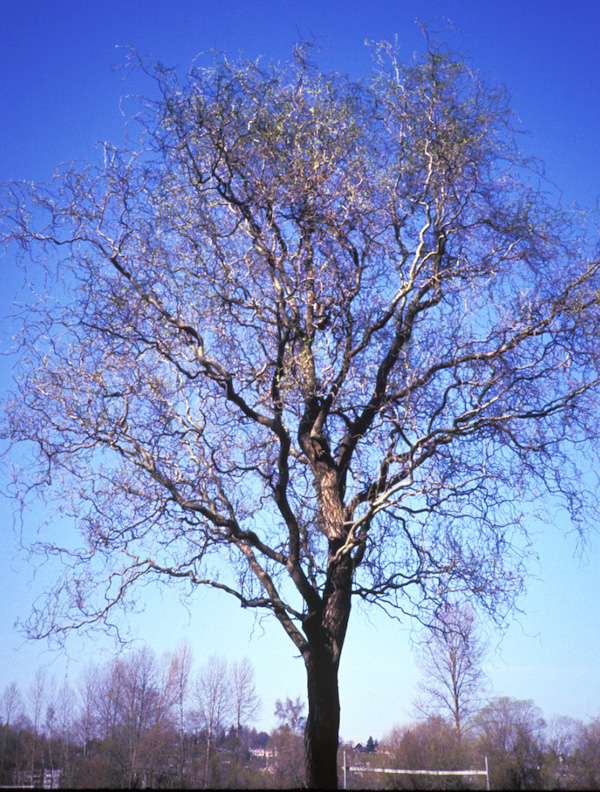
Corkscrew willow in winter ; photo by ALJ
|
| Golden Corkscrew Willow |
| Salix × pendulina Werd. f. erythroflexuosa I.V. Belyaeva 2018 |
| = Salix 'Erythroflexuosa' |
| = Salix 'Golden Curls' |
| (Salix babylonica 'Tortuosa' × Salix × pendulina f. tristis 'Chrysocoma') |
Originally from Argentina in 1961. By 1972, sold in North America. In Seattle, a young, common female clone. A similar cultivar, male, with reddish twigs is 'Scarcuzam' = 'Scarlet Curls'.
|
| Peking Willow |
| Salix babylonica var. pekinensis Henry |
| = Salix Matsudana Koidz. |
| In Seattle, known as a large very old tree at Madrona Park. Female; catkins one half to one and a quarter inches long. Also called Hankow Willow. Maybe the city has one or two younger examples, but I must verify that. |

Peking willow in fall color ; photo by ALJ
|
| Crack Willow |
| Salix euxina I.V. Belyaeva 2009 |
| = Salix fragilis auct., non L. |
| Salix fragilis, long thought a species, is really a hybrid between Salix alba and Salix euxina. The later is native from Turkey to the Caspian Sea, and only named in 2009; the Latin name euxinus refers to the Black sea. Scarcely any purebred specimens of true Crack Willow (Salix euxina) grow in Seattle. Crack Willow --or its hybrids-- are also called Brittle Willow, Snap Willow, or Redwood Willow. The purebred version is rarer in cultivation than its hybrids, is rounded in shape, smaller, less ornamental, and its twigs are annoyingly brittle. Put a twig in water and it grows pink roots, slowly; whereas White Willow grows white roots, quickly. The arboretum specimen #80-73, that was 28.5 feet tall in 2005, is now 24.5 feet tall, but 46 feet wide. It split. |
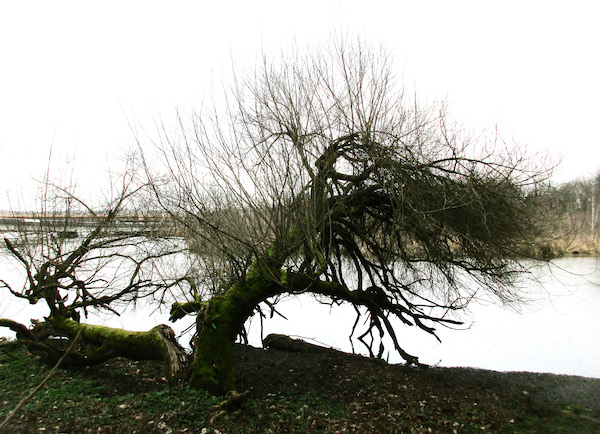
Crack willow in winter ; photo by ALJ
|
| Babylon Weeping Willow |
| Salix babylonica L. |
From W China, not Babylon. When this species was named in 1738, it was believed to be the one referred to in Psalm 137: "By the waters of Babylon, there we sat down, yea, we wept, when we remembered Zion. We hanged our harps, upon the willows in the midst thereof." Introduced to western Europe from Turkey in the late 1600s; in England by1730. In North American commerce by1790. One of the world's most celebrated and distinctive trees. True Babylon Weeping Willow is cold-tender, and though common and naturalized in the southeast U.S. (occurring in both sexes), it is relatively rare on the West Coast (mostly a female clone), and nonexistent in cold regions northward. Trees of the north called Salix babylonica are simply its hybrids. In Seattle, either extremely rare, or none remaining --except a few of the following Ringleaf cultivar.
|
| Ringleaf Willow |
| Salix babylonica 'Crispa' |
| = Salix babylonica 'Annularis' |
Leaves curled in strong rings and spirals. A small, weak tree; not as strongly weeping. Female; catkins 1 inch long. Other names are Hoopleaf Willow, Screwleaf Willow, and Ram's-Horn Willow.
|
| Hybrid Weeping Willow |
| Salix × pendulina Werd. f. tristis (Gaud.) I.V. Belyaeva |
| (S. babylonica × S. × fragilis f. vitellina) |
Seattle has more than one clone/cultivar of this. The two most common are as follows:
|
| Golden Weeping Willow |
| Salix × pendulina Werd. f. tristis (Gaud.) I.V. Belyaeva 'Chrysocoma' |
| = Salix × sepulcralis 'Chrysocoma' |
| = Salix × chrysocoma |
| Very common, a male with catkins to 3 inches long, golden twigs, grown since the late 1800s. Also called Niobe Weeping Willow. Our most common, largest, prettiest weeping willow. More than one in Seattle has measured 80 feet wide. The Greek name means chryso (golden) and kome (tuft of hair). |
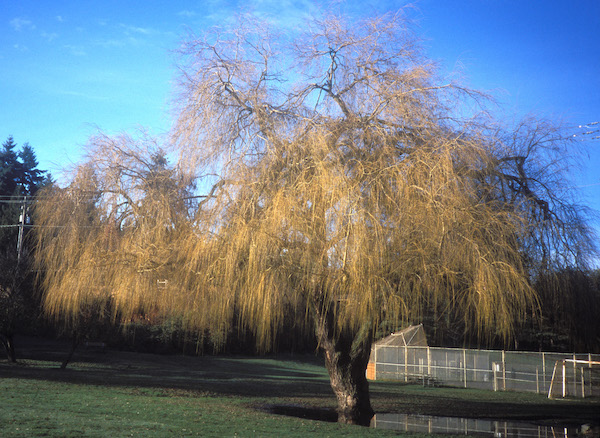
Golden Weeping willow in winter ; photo by ALJ
|
| Sepulchral Weeping Willow |
| Salix × pendulina Werd. f. tristis (Gaud.) I.V. Belyaeva 'Salamonii' |
| = Salix × sepulcralis Simonk |
| = Salix × Salamonii Carr. ex Henry |
| (S. babylonica × S. × fragilis) |
In Seattle, uncommon, a female with catkins one and a quarter to two inches long. Twigs olive-green rather than golden. Also called Salamon Weeping Willow. Very late to defoliate in autumn.
|
| White Willow |
| Salix alba L. |
| Also called European White Willow and Huntingdon Willow. None of these are known in Seattle. White Willow is not white literally, but in its original appearance, it appears relatively pale compared to many other European willows. Its typical version --as regards to botanical taxonomy-- has dark, silky hairy twigs and leaves. Yet its range of variation includes hairless versions called var. calva, and extra hairy versions called var sericea. This map shows the White Willow natural or original European geographic range in green, plus orange triangle areas in which people have planted it. The map is from Genetic analysis of Latvian Salix alba L. and hybrid populations using nuclear and chloroplast DNA markers by Dainis Rungis et al. (2017). |
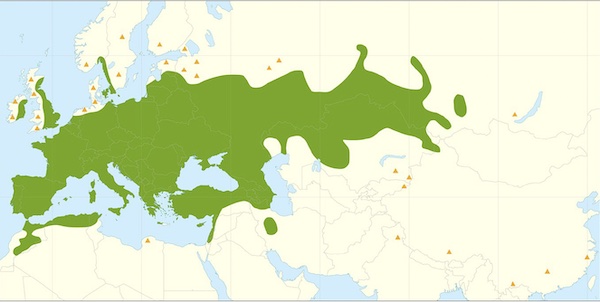
White willow geographic range
|
| Cricketbat Willow |
| Salix alba var. caerulea (Sm.) Sm. |
| = Salix alba var. calva G.F.W. Mey. |
First described in 1700. Also called Blue Willow, its leaves are conspicuously glaucous beneath. It is less hairy than typical White Willow. Its branches grow strongly upright. Extremely rare in Seattle, being fungal-prone and short-lived. All noted are female, making catkins from half an inch to an inch and a quarter long.
|
| Silver Willow |
| Salix alba var. sericea Gaud. |
| = Salix alba f. argentea Wimm. |
| Cultivated in Europe since the early 1800s. Foliage densely and persistently silvery-hairy. Sericea means silky in Latin. All noted are female, making catkins up to two and a half inches long. Also called Royal Willow. Undeservedly extremely rare in Seattle; it is a splendid ornamental. |
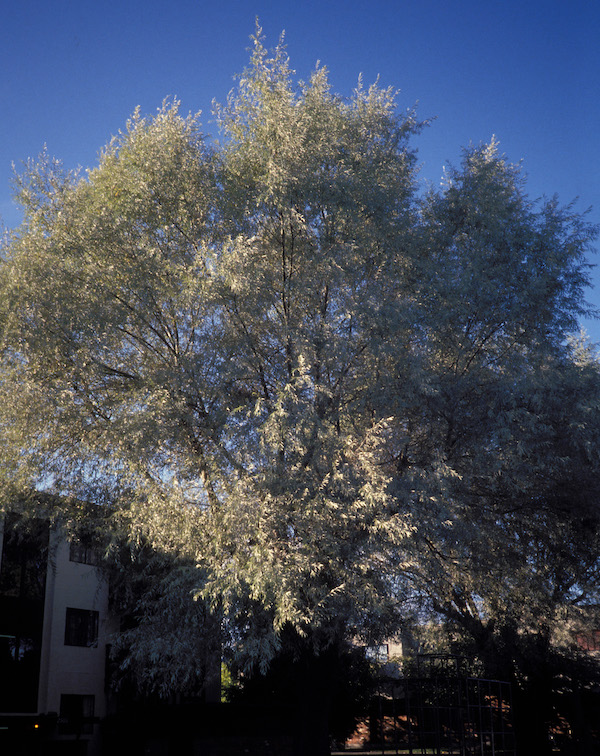
Silver willow in summer ; photo by ALJ
|
| Goldtwig Willow |
| Salix × fragilis f. vitellina (L.) I.V. Belyaeva 2018 |
| = Salix alba var. vitellina (L.) Stokes |
| Cultivated since the 1600s, this hybrid, also called Golden Willow, Yellow Willow, and Russian Yellow Willow, has winter twigs that are lemon-yellow, golden, or red. The name is from Latin vitellus, egg yolk, referring to the twig color. The tree is common in Seattle, and even naturalized. Some are over 80 feet tall. Most in Seattle are male, with catkins two and a half to four and three-eighths inches long. Female catkins are 2 to 5 inches long. This tree grows as large as any other willow. |
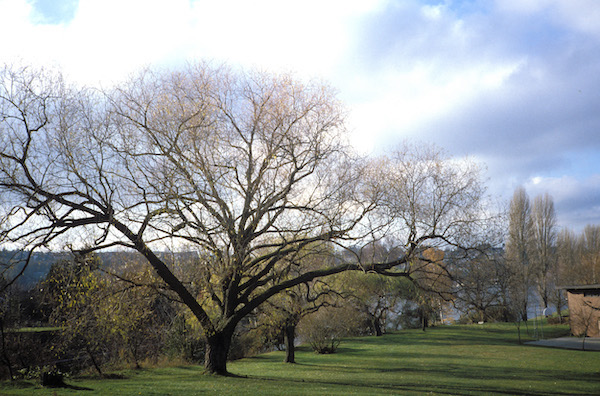
Goldtwig Willow in winter ; photo by ALJ
|
| Golden Partly-Weeping Willow |
| Salix × pendulina f. tristis 'Vitellina-tristis' |
| First named in 1815 in Switzerland. Extremely rare in Seattle. A female with golden twigs; catkins about 3 inches long. Not as pendulous as Golden Weeping Willow ('Chrysocoma'). The one I photographed is about 65 feet tall and wide. Its trunk forks low into two. |
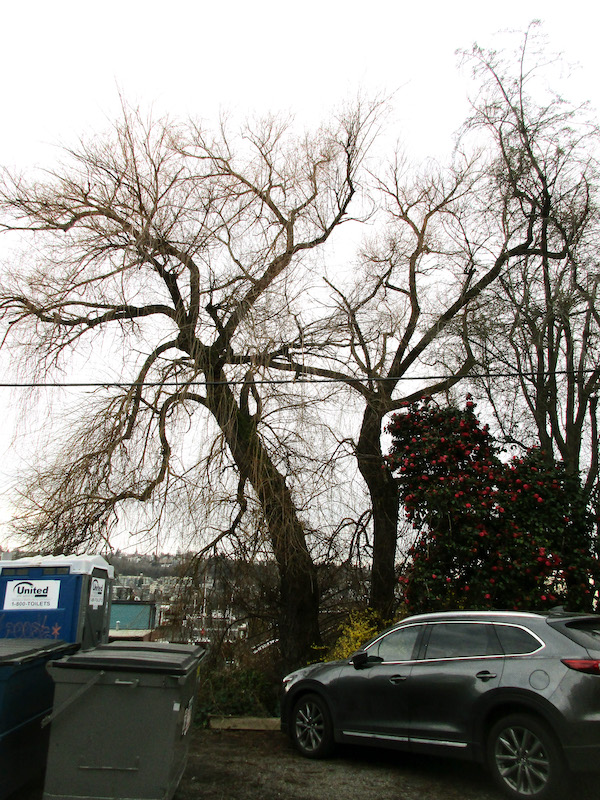
Golden Partly-Weeping willow in winter ; photo by ALJ
|
| Hybrid White Willow / Hybrid Crack Willow |
| Salix × fragilis L. |
| = Salix × rubens Schrank |
| (S. alba × S. euxina) |
Seattle once had several beautiful clones/cultivars of these trees, one called Rochester Willow, but as far as I know the city now has only three specimens of an old female on Lake Washington Boulevard in the Washington Park Arboretum, by the stream, south of the Lynn Street viaduct footbridge. These had been planted by the Park Department, and were not official arboretum accessions. The tallest is 77 feet. Catkins one and three-fourths inches long in bloom, lengthening to 2.5 inches in seed. In winter, these trees are somber and drab. In full summer foliage, they appear luxurious and their foliage shines.
Back |

Weeping willow drawings by Ing. Jindrich Chmelar, in Weeping Willows, pp. 107 - 110 in International Dendrology Society Yearbook 1983
|

